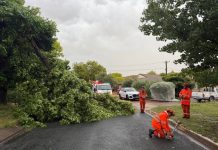Heavy rainfall has prompted concern about the potential impact on water quality for the ACT following recent bushfires in the region.

Icon Water implemented measures to reduce the runoff of ash and sediment into the Corin Dam ahead of the rain and acknowledged that “depending on the damage to vegetation caused by the fire as well as the amount of rainfall, there can be varying impacts to water quality”.
“Our team will have access to Corin Dam today (11 February) to assess impacts in and around the raw water supply catchments and determine if additional mitigation actions are required,” an Icon Water spokesperson said. “Icon Water will continue to monitor the impacts of the fires on the catchments and water quality. We will continue to select the best quality water available and if required, use the technology at the Mt Stromlo and Googong water treatment plants to process the turbidity caused by ash or sediment in the water supply.”
Following the 2003 bushfires, Icon Water further upgraded their water treatment plants to ensure they could remove ash or sediment erosion if this were to enter the water supply following another bushfire.
“As well as the upgrade to our treatment plants, there were further measures put in place during the Cotter Dam enlargement to protect the water supplied from this catchment,” the spokesperson said.
As at 11 February, the rain has resulted in only a small increase in storage levels so far.
“It will take sustained rainfall over an extended period or a return to average rainfall conditions to significantly increase Canberra’s water storage,” the spokesperson said.
According to data from the Bureau of Meteorology, on Monday 10 February the highest rainfall in the ACT was recorded at Mount Ginini with 76.4mm. Canberra Airport recorded 60.4mm with 52.0mm in Tuggeranong.
The wet weather prompted numerous calls to the ACT State Emergency Service (ACTSES) for assistance. As at 5pm on 10 February, ACTSES was working to respond to more than 440 rain damage incidents around Canberra.
The rain also provided welcome relief for those battling the Orroral Valley Fire. In an update at 9am on 11 February, the ACT Emergency Services Agency (ESA) said the fire is now contained, meaning the whole perimeter is behind identifiable control lines.
While they acknowledged the recent rainfall “will not extinguish the fire”, the “milder temperatures and continued rain will greatly assist the fire suppression efforts”.
As a result of the favourable weather, the State of Alert that was in place for rural and remote parts of the ACT was lifted on Sunday 9 February. It was first declared on 2 January to allow the ESA to further prepare in case of an emergency.
ACT Minister for Police and Emergency Services Mick Gentleman said there is “a growing list of lessons learned and the lower risk means we can start to take stock of the damage”. It is estimated the fire has burnt through about 80% of Namadgi National Park.
“Rapid response teams are being deployed and will report back to Government a clearer picture of the damage to ecology, heritage and parks assets like paths and signs.”








